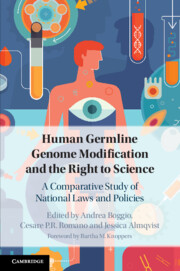 Human Germline Genome Modification and the Right to Science
Human Germline Genome Modification and the Right to Science from Part II - Europe
Published online by Cambridge University Press: 15 November 2019
For historical, social, political and religious reasons, Italy has traditionally approached life sciences, especially those involving humans, with great caution. The main law touching on human germline genome modification, called Law 40/2004 (‘Rules on Medically Assisted Reproduction’) bans most ‘experimentation’ on human embryos. In addition, EU Regulation 536/2014 contains a ban on clinical research using germline modification technologies. Nevertheless, Article 13 of Law 40/2004 leaves the door open to clinical applications of germline modification technologies. However, only the improvement of basic research on gametes would permit in the future to decide if, and possibly identify which, clinical applications are scientifically feasible and ethically acceptable. Recent developments and new possibilities in the field of human germline genome modification call for regulations that, while setting limits to contain possible abuses, do not wholly frustrate scientific and technological progress. Moreover, human germline genome modification technologies, which have enormous therapeutic potential, can further certain values enjoying a constitutional status under the Italian legal system, such as the promotion of scientific progress and the protection of health.
To save this book to your Kindle, first ensure no-reply@cambridge.org is added to your Approved Personal Document E-mail List under your Personal Document Settings on the Manage Your Content and Devices page of your Amazon account. Then enter the ‘name’ part of your Kindle email address below. Find out more about saving to your Kindle.
Note you can select to save to either the @free.kindle.com or @kindle.com variations. ‘@free.kindle.com’ emails are free but can only be saved to your device when it is connected to wi-fi. ‘@kindle.com’ emails can be delivered even when you are not connected to wi-fi, but note that service fees apply.
Find out more about the Kindle Personal Document Service.
To save content items to your account, please confirm that you agree to abide by our usage policies. If this is the first time you use this feature, you will be asked to authorise Cambridge Core to connect with your account. Find out more about saving content to Dropbox.
To save content items to your account, please confirm that you agree to abide by our usage policies. If this is the first time you use this feature, you will be asked to authorise Cambridge Core to connect with your account. Find out more about saving content to Google Drive.